|
|
Welcome to my travel log! You will find here a lot more than in the travel reports, stripped from political correctness. Enjoy! 
Mar 26, 2006 02:00 PM Busua - what a resort!
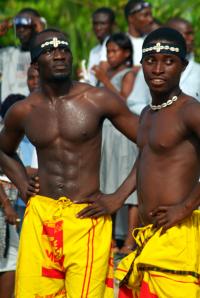 The hotel enjoyed a reputation to be amongst Ghana’s best beach resorts. It meant that even the US ambassador was staying there as she was supervising the arrival of the US warship in Sekondi.
The hotel enjoyed a reputation to be amongst Ghana’s best beach resorts. It meant that even the US ambassador was staying there as she was supervising the arrival of the US warship in Sekondi.
The hotel was full, but this must have been connected to the total eclipse, on the central like of which Busua lied, rather than its quality. I say that because the facility must have had the worst and slowest service on this planet. I was not the only one complaining about it. The minister of tourism was also totally unimpressed. He actually complained several times to the waiters that it was totally unacceptable to be waiting twenty minutes for a drink to be delivered.
I shook the minister’s hand on the beach walking from one beach bar to another. Actually, before I forget, at the Alaska Beach Club, I was provoked to settle an argument. I asked Philip what on hell the bunch of guys at the other table were arguing about, and he told me that they were shouting at each other disagreeing on whose mobile phone was better. I therefore decided to put them all to shame by revealing my new extra slim Motorola Sliver.
I should have not done that because since then the people treated me as expert in any possible field. I had to resolve the remaining argument, whose mobile was actually the worst. Fortunately, I knew what I was doing. I must have had twenty different handset in life by then. I was later asked, which eclipse shades were fake and which were safe to look through. Again, I knew something about it, and could give an honest and genuine opinion. By the way, all of the shades were actually fine, although giving slightly different colour of the sun.
Then, the lady owner asked me to give feedback on her blackboard menu and the quality of English in which it was scribbled. I have to say that I found it funny how many mistakes one could make in a four line menu special.
Now, back to the minister. When I met him on the beach (his name was Steve), he told me a little about plans he had regarding the area. He wanted to build a small restaurant on a tiny rocky islet off shore and construct the longest wooden, floating bridge there. I think he was fantasising. However, this was the minute when I found that the fort in Butre was left to itself. I told the minister Steve that the fort was in a good shape and had a great potential. He responded with the Yoda-like hmm...
The minister and his wife came to Busua for the eclipse and of course they brought the national television along to do a live coverage of this celestial event. This meant two things to me. One: the minister knew much more about the weather forecast for the eclipse, and since it was a rainy season and clouds were getting on my nerves, I felt a little more comfortable about the aura.
Second: he provided me, and obviously all the other guests, with free entertainment of singing, dancing and drumming. Three different groups came to do artistic programmes.
The first group was awful. There was only one girl and a short boy, who danced well, and who, one could clearly see, did it with emotion. The rest was sluggish and did it like it was torture to them.
Later in the evening I met the guy in the village and I gave him a tip asking him to share it with that girl. He was so overwhelmed that he hugged me!
|
Mar 26, 2006 02:00 PM Secondi - Fort Orange
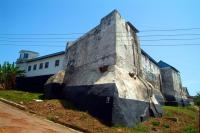 The map I had with me was not clear where the Fort Orange, built by the Dutch in 1690 was to be found exactly. It looked like it should be located in Takoradi, yet that was not the case.
The map I had with me was not clear where the Fort Orange, built by the Dutch in 1690 was to be found exactly. It looked like it should be located in Takoradi, yet that was not the case.
Eventually, I found it in Sekondi, overlooking the naval port. It was used as a lighthouse and many lighthouse men lived on the premises. One of them took me on a short tour. I was skeptical about it, but I was shocked how much he knew about the forts in Ghana and this particular one.
He knew very well that the name Orange came from the name of the Dutch royal family, who at that time, were asked to take over the temporary Republic of England headed by General Cromwell and the Parliament. When the Oranges did, Britain reverted back to monarchy.
The guy knew much more, and yet he told me a totally unbelievable story.
He walked me through the fort and showed me the dungeons. At one of them he paused and vastly overstating the number of slaves who had been kept there and told me this:
“The smaller room next to the male dungeon was used for torturing the men. Only the big and strong males. It was because sometimes, they were trying to take control and trigger mutiny. So, the traders would take them down and torture them to death to set an example.”
Now, this might sound a little insensitive, but I found it hard to believe the story. Those slaves were already paid for. What economical sense would it make to purposely kill an expensive slave? Big and strong men were very expensive, and yes, it was risky to allow for mutiny. However would it not be sufficient to keep them separately from the others? An interesting story though. I found no trace of machinery, which allegedly had been used in the room.
Later, my guide told me that he had a book about the slave forts in Ghana. This is why he was quite knowledgeable.
The lighthouse added to the fortress was in full operation. The view from the towers of the fort were ... rather dangerous for photographers. The naval port holding a few armed vessels was just too well visible and of course it was strictly forbidden to take any pictures of it. If I did take a picture there, would the navy know, though? Did they have surveillance switched on the fort just in case? I did not know.
Later in the week, an US warship was coming for manoeuvres, and the US ambassador was visiting the area. I heard her on the radio talking about it. The ship was also bringing some more people for the peace corp.
Yes, the radio was a bit a problem for me. It did not work very well, so for the majority of my rides I had the air-conditioning to listen to. The car had an aerial, but the signals must have been very weak, because I was getting either rubbish, screeching noise or absolutely nothing. I so regretted that I did not take the iTrip with my iPod Nano with me. I would have created my own airwaves from my pod.
Sekondi, together with Takoradi made the largest twin town in Ghana, and I could not stand it. It was noisy, dirty and totally unorganised. Seriously, Fort Orange was the only reason to come there for tourists. Oh, yeah and the banks, which were the only ones changing money in the area.
|
Mar 25, 2006 07:00 PM Elmina - local football match
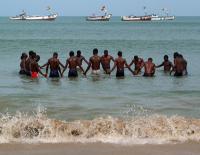 Elmina sounds like a name of a beautiful girl. And it became definitely my favourite place in Ghana.
Elmina sounds like a name of a beautiful girl. And it became definitely my favourite place in Ghana.
The fort, the Castle of St. George, is arguably the oldest European building in sub-Saharan Africa (the other is a small chapel on the Mozambique Island) and definitely one of the most extensive. Construction started in 1482, but since then, the castle had been extended so many times that it does not resemble the small little hut it was in 1492.
It was great to visit it. Its size could easily rival the Cape Coast Castle, however its state could not. Although it was made a museum, the interior was still in ruin. I noticed an extensive effort being spent to renovate the fortress. Many of the rooms had wooden scaffolding inside them, tools and paint scattered around, and evidence of something happening. Work was not moving very fast, though. Like anywhere in Africa, I might add.
It was a superb observation point as well. Entire Elmina could be seen from the bastions and walls, the ‘shipyard’ of wooden vessels, the recreation beach, the toilet beach, the fishing harbour and the town.
The castle, however, was the reason why Elmina had become my favourite place in Ghana. It was Elmina’s semi-professional football club - Panya FC.
I met them when they were getting ready in their castle for their match. A few drums lied around in the courtyard they were using, so I thought they were players of a different kind.
I went down to meet them. They corrected me and told me about they football team. They wore white and red uniforms (like my national team), so I decided to support them. And you know what? They lost that day. It was, apparently, their first defeat in the season. They were really down! Seriously, not a pretty picture at all.
The match was an important event in Elmina. The football pad was packed and the crowd was responding spontaneously. I would even say that some of them acted dangerously. Many ran inside the pitch waving their hands crazily. There were many scary looking arguments and fights.
I felt somewhat sorry for Panya FC, and to ease up their frustration, I decided to sponsor them a little. I gave them two hundred US dollars. From deep sorrow they immediately turned to screaming and jumping like little boys.
They invited me to their next match and promised me that they were going to win it. I had some flexibility in my itinerary so I promised that I was going to return to Elmina and see them in action again. Apparently, they had never had a white supporter and they were thrilled that I was not only supporting them but also sponsoring them a little.
In the evening, some of the guys took me out in Elmina. I went in a few local drink bars and almost entire Elmina knew me. The news that I gave the boys some money travelled with the speed of light as many Panya FC local supporters recognised me and asked for confirmation of my sponsorship. My hand was shaken many times that evening. It felt good and my name was shouted by many.
|
Mar 25, 2006 07:00 PM Cape Coast - Massive Castle-Fort
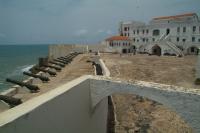 After abandoning Anomabu, as the centre of their slave trade, the British moved to Cape Coast and adopted a small fort erecting a giant castle there. Its purpose was to compete with the super-strong Portuguese, later Dutch, Castle of St George in Elmina, only fifteen kilometres away.
After abandoning Anomabu, as the centre of their slave trade, the British moved to Cape Coast and adopted a small fort erecting a giant castle there. Its purpose was to compete with the super-strong Portuguese, later Dutch, Castle of St George in Elmina, only fifteen kilometres away.
The Cape Coast Castle, along with its counterpart in Elmina, had been centres of possibly the most horrific and long-lasting crimes against humanity. The number of people dispersed from their homes via these facilities is beyond belief. The approximate (!) 28 million people forcibly shipped across the Atlantic changed the face and the economy of the entire planet. The slave trade undisputedly created the America’s wealth and fortunes, and devastated Africa.
Yet, the Cape Coast Castle does not make an impression of the centre of evil. It is rather pretty, architecturally brilliant and painted white. From the side I approached the castle, different from the one Philip used to do, the fort did not look large at all. The main wall was not very high and the entrance looked inconspicuous. Then, when I entered the main court, I was officially impressed. The extent of the stronghold was dazzling.
I am not sure if I was more excited or terrified by it all. I have never seen so many cannon balls in one place before. Or so well preserved cannons lined up immaculately along the main walls of the castle, watching over the ocean.
I refused to take a guide with me. I was supposed to ‘do’ the museum, which was rather boring and packed with cliches, and then come back to the entrance and pick up my guide. What I wanted to do was to wander around the fortress and soak the atmosphere without anyone disturbing me with stories I already knew.
I am not sure how long I wandered around the castle, but I had to change 1Gb memory card in my camera. The views from the fort were great. Immediately from the southern outer wall, I had a great glance at the fishing process. Many fishermen were still collecting the vast nets from the sea. It was a late morning and they were still doing it.
The rocks right at the feet of the wall provided a great place for the locals to relief themselves. The smell of the excrement successfully penetrated even the top rooms of the castle’s main building.
The eastern part of the town and its beach were beautifully available for a view as well. I was surprised to see how close the everyday life of the town found itself to this giant fort. The fishing shipyard and netting workshops almost leaned on the fort’s walls, which provided protection from strong winds and scorching sun. How ironic? For this castle was designed to ruin the local’s lives.
I walked around taking pictures. I was amazed with the sheer size of everything, the walls, the bastions, even the courtyard.
Apart from the Cape Coast Castle there were two other forts in town: Fort William and Fort Victoria. Both of them were very small, which suggests that they were used primarily as observation points and first strike of fire. And both of them were very strategically built on hills, providing excellent views for several kilometres around.
It was very hot that day. At least it felt like it. So, I only ventured to the Fort William, near the centre of the town. When I got there, I found a near perfect fort. It was a tall building encircled by a very high round wall. It was almost impenetrable. It had only one entrance through a very narrow and rusted stairway. There was no door in the wall. One had to climb over the wall. That was the only way.
Inside the fort, I found, to their greatest surprise, a number of families living there. It was their home, they said. And it certainly looked like they had converted the fort into a comfortable, and most of all, safe place to live. Their washing was scattered around purposely and a loud music was blasting from a single radio unit. It was completely inaudible from outside.
When I came, with my driver, who was flabbergasted by my determination to get inside this particular fort, and explore all the forts in Ghana (he was making very funny faces like almost he was shitting himself at that very moment there). Many of the people inside got quiet and only one girl decided to act as a host. She did not have to, but accompanied me upstairs.
The fort was officially designated the role of a lighthouse in 1855. This lighthouse, however did not work when I visited, and there was no operator. I was intrigued by the fact that those people were actually allowed to live there. I am sure there would be many others in town, who would like to possess a mighty fort as their home. I guess I missed the boat by not finding out how that worked. I met a few people from Cape Coast and I never asked them what they thought about those who took over the Fort William.
From the top of the fort, a superb view extended very, very far. With sufficient visibility, the castle in Elmina might even be seen, perhaps. Elmina’s vessels, at the other hand, certainly would be! I said it was a near perfect fort, didn’t I? I could definitely see Cape Coast’s third fort, the Fort Victoria, from there. I was told that it was disused and strangely enough I did not find anything about the fort. Not that it was not available, I just did not pursue it.
|
Mar 25, 2006 07:00 PM Anomabu - small life guards
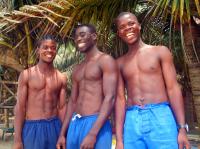 The place was very popular with the better situated locals and expatriates. Particularly at the weekends. When I came (Saturday afternoon), I got the last room available and the resort was full. The beachfront bar and restaurant were not big enough to accommodate everyone at a time.
The place was very popular with the better situated locals and expatriates. Particularly at the weekends. When I came (Saturday afternoon), I got the last room available and the resort was full. The beachfront bar and restaurant were not big enough to accommodate everyone at a time.
In the morning, I met three lifeguards, who were looking after the guests on the beach. They did not have a light life. They worked from 6 o’clock in the morning and not only did they have to watch the guests in the water, but also provide beach beds, deck chair cushions and act as security.
They were funny lads, too. They told me that normally they worked in pairs, and only on Sundays all three of them worked together. When they applied for the job, the owner said that it was hard to believe that small boys like them could be lifeguards. It was very funny. She might have meant their age, as they looked rather fit to me, strong arms and washboard stomachs complete with six-packs.
|
Mar 24, 2006 07:00 PM Senya Baraku - Fort of Good Hope
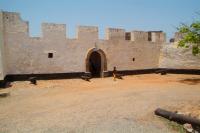 The first fort I visited in Ghana was the Fort of Good Hope, built by the Dutch in 1704 in the village called Senya Baraku.
The first fort I visited in Ghana was the Fort of Good Hope, built by the Dutch in 1704 in the village called Senya Baraku.
It was rather hard to find the fort. There were a few signs indicating the direction and inviting for a visit, but their number and positions were insufficient. I almost directed Philip, my driver, in a wrong direction. Philip never had been to Senya Baraku and my whole trip was an adventure for him as well. I actually left him my map of Ghana at the end of my holiday. He was ever so happy.
Fort of Good Hope was not large, and I got a feeling that many others I was going to see along the coast, were going to be larger. Its location was great though. When I approached the fort from the village, I did not expect it to be clinging to a high cliff and overlooking the coast, the busy fishing beach and the rest of village.
The front walls of the stronghold were whitewashed and although their size did not take my breath away, the entrance to the fort was in a very classical fort-like form. I really liked that.
I could be wrong but I think there were a few families occupying the fort. One of the guys lingering at the main gate decided to cash on my visit and gave me a short tour, which set me back twenty thousand cedis (about two US dollars).
I did not stay long there. I went down to the beach to see what the fishermen were doing and to check if there was a nice view of the fort from the water’s edge. The fishermen were unloading the catch of the day, and the view was not that special.
|
Mar 24, 2006 07:00 PM Anomabu - Fort William
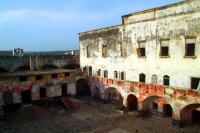 Quite unusually, Anomabu enjoyed strong independence despite the presence of various settlers from Britain, Netherlands and France. When the British stayed in the area, they built Fort Charles and established their largest slave centre there, relaying mainly on the local black traders, who sold their brothers and sisters. The original fort was destroyed in 1731 but 25 years later, the Britons constructed a very solid stronghold. The fort changed its name to Fort William in the nineteenth century.
Quite unusually, Anomabu enjoyed strong independence despite the presence of various settlers from Britain, Netherlands and France. When the British stayed in the area, they built Fort Charles and established their largest slave centre there, relaying mainly on the local black traders, who sold their brothers and sisters. The original fort was destroyed in 1731 but 25 years later, the Britons constructed a very solid stronghold. The fort changed its name to Fort William in the nineteenth century.
Ghana used the fort as a prison until recently, and although it represents one of the most significant forts on the UNESCO World Heritage List, photography of it was severely punishable.
Gladly, I found that it was no longer a case, and the structure was in great shape (picture above, of course). As soon as I started snapping, I was found by an eager caretaker, who offered me a tour of the fort. I could not actually believe it! Yet, he took out his key and opened the side entrance of this dark facility.
He showed me around and said that I had all the time of the world to visit it. I took his advice. I could do it, since I had cunningly checked in at a nearby resort some twenty minutes previously. First he took me to the bastions, which offered superb views of three beaches.
The first one was a nudist beach, I would call it. It was a small piece of the coast right in the front of the fort, where local men and kids were bathing. I later found that this was a common practice along the Gold Coast of Ghana.
To the east of the fort, there was the fishermen beach. It was nicely shaded by countless palmtrees and the boatsmen used this spot to mend their vessels and fishing gear.
The western beach was a regular beach used for recreation. There were a few fishing boats on it as well, but I could see that the locals used the beach to play football and kill time.
From the fort’s bastions, for the first time I saw the open air showers used exclusively by men. I saw similar showers in Mali before, but those were situated right on the beach and only men used them. Typically, the guys were taking a dip in the ocean and then, using soap, etc., took a bucket shower in the cabins. They would bring fresh water from somewhere in the town. This was also a common thing in Ghana.
This meant however, that women and girls were not allowed in this part of the beach where the showers were located.
I think Fort William was among my favourite strongholds in Ghana. It looked much like a castle. When I went to see the dungeons, I knew they were not fake. A few chain rings were still there, and those fixed to the floor made the strongest impression on me. They definitely stirred my imagination. I could not tell however, whether they were used for slaves or, more recently, for prisoners.
Contrastingly, I checked in at a very nice resort nearby, the Anomabu Beach Resort. Although my room had no air-conditioning, it was a nice and spacious hut and I loved the gardens, the beach, the restaurant and the personnel.
|
Mar 24, 2006 07:00 PM Abandze - Fort Amsterdam
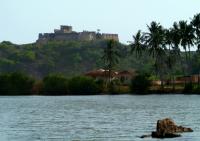 The fort I wanted to see was perched on a hill in the village called Abanze (not Saltpond), right across the Etsi Lagoon. It was the first fort built by the British along the Golden Coast and dated back to 1631.
The fort I wanted to see was perched on a hill in the village called Abanze (not Saltpond), right across the Etsi Lagoon. It was the first fort built by the British along the Golden Coast and dated back to 1631.
Fort Amsterdam, this is how it was known, after it had been traded with the Dutch (previous name was Fort Cormantin) had an interesting impact on the history. The English traded the fort with the Kingdom of the Netherlands for the island of Manhattan with the town of New Amsterdam on it, promptly renamed New York.
Also, the vast majority of the slaves shipped from this fort landed on the Caribbean islands, and acquired a name of the Cormantins, which is closely associated with the village Kormantze, lying one kilometre east from the fort. I think the best view of the fort is exactly from Kormantze’s Etsi Lagoon, and conveniently from the main Accra - Takoradi highway.
My sources stated that the stronghold had been rebuilt by the Ghana’s government in 1951, but when I visited the fort, it was badly ruined. From the outside it looked fine, but inside the main house was substantially damaged. How that could be, I did not fully understand. Not that I cared either, though.
A self appointed caretaker, charged me for a visit the usual twenty thousand cedis, which must have been the ‘without-a-receipt official price’.
I am not sure why but I did not like him that much. I found him too cheeky. He did know the history of the fort well, but when I visited, I felt like I was invading the family who appeared to be living within the fort.
A little child was afraid of me as soon as entered inside. Other kids around thought it was funny, but I did not shared their opinion. I told them to tell the toddler to stop crying and that I was going to give it a glossy magazine about cars, which I picked up at the Heathrow Airport business lounge. The trick worked.
Since I felt somehow under pressure, I decided to make a speedy tour of the fortress and get out of there. Fortunately, two other white tourists came and the caretaker thought they might have been a better catch and quickly took care of them. I used this precious moment to accelerate my visit and leave promptly.
The kids remembered my promise about the magazine so almost all of them followed me to the car. I gave the child the magazine and had to engage in a dodgy conversation with a guy who claimed he was guarding my car.
My point was that he was not there when I arrived and I did not think it was unsafe in Abanze so I did not need to hire a guard. My driver Philip knew exactly what was going on and strategically kept out of the discussion.
He later told me that he could not believe how polite I was with that cheeky crook.
|
Mar 24, 2006 07:00 PM Apam - Fort Patience
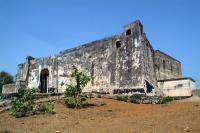 I thought I could be staying in Apam that night, but I was extremely happy that it did not happen. First of all it was too early to call it a day, when I reached the town and second of all, the guest house at the Dutch Fort Patience (built in 1697) scared me.
I thought I could be staying in Apam that night, but I was extremely happy that it did not happen. First of all it was too early to call it a day, when I reached the town and second of all, the guest house at the Dutch Fort Patience (built in 1697) scared me.
The interior was barren, sad and Spartan. Completely in line with the age of the structure. This must have been the smallest fortress that I saw in Ghana, and its size casted a shadow of a doubt whether this stronghold had ever been used for keeping slaves.
The ‘guide’ of the fort would strongly disagree with this theory though, as he had a number of slave packed stories about the fort, including the typical ‘male dungeon’, ‘female dungeon’, and obligatorily the ‘door of no return’. I hope I did not leave any impression that I did not believe a word the ‘guide’ was reciting.
The fort looked quite grotty. I think it must have been restored some forty years ago and then left to its own since. I think the venue did not see many visitors at all. The guard (oh, I’m sorry, the ‘guide’) was sitting at the doorstep chatting to a colleague, when I arrived. He was actually very pleased to see me, and, eventually, the donation of twenty thousand cedis I gave him.
By the time, I reached Apam, I knew that the distances between the forts I wanted to see and Elmina, my third stop, were not so great. Yet, I was not in a hurry because the total eclipse was still five days away and I did not feel like staying in Busua for too long. So, I thought that I should find a place for the night somewhere near.
The thing was that I could not rely on my driver, because he had not been anywhere outside Accra, but Elmina and Cape Coast. He had no idea about the forts, that there were so many of them, and could not suggest places to stay. So, back to reading.
I chose Anomabu. It was described as an attractive town with splendid beach, great fort and superb resort on the coast. Anomabu was not far, and I soon communicated the amended itinerary to Philip, who I think did not actually care.
Timing was right, because there were at least two other forts I was going to see before sunset.
The next one was very interesting from the history point of view. I actually thought it was going to be in the town called Saltpond and I was wrong.
|
Mar 24, 2006 07:00 PM Winneba - a village of friendly fishermen
 As I declared my next destination to Philip, Winneba, I was rather unsure why I wanted to go there. I knew there was no fort in Winneba, and I had to check in the guidebook what I was actually going to see in the town.
As I declared my next destination to Philip, Winneba, I was rather unsure why I wanted to go there. I knew there was no fort in Winneba, and I had to check in the guidebook what I was actually going to see in the town.
Busy fishermen waving and inviting me to check out what they were doing was the scene, which I saw. Exactly what the guidebook stated. The picture was similar to the one I observed in Senya Baraku, but the multiplicity of the boats looked like it was generated by a nerd, who perfected its computer special effects wizardry. I lost my count after couple of hundreds.
I stopped the car in the waterfront street and started hiking along the coast. I do not know if it was my camera swinging from my arm or simply my curious eyes, which prompted many of the fishermen wave at me invitingly. I did approach a few to have a closer look what they had in their nets. It was nothing. The catch must have been collected much earlier and they were just repairing their nets.
The streets of Winneba were extremely busy. I was impressed to see how many people and vehicles they managed to pack. When I entered the market, I found it difficult to move. People were not necessarily moving out of the way for others at all, in their typical African way.
One could buy anything on the market. The range of items and their colours would challenge the fastest and largest computers on this planet. I could argue the fact that if one could not find what they were looking for, it would mean that the thing simply did not exist. I like this overstatement, actually.

Young lads diving from a rock on the beach risked their bones since the ocean was not very deep there. I could definitely see it was a happy day, though. It was Saturday, the school was off and everyone enjoyed themselves. I kept thinking why, oh why I decided to move to a country with rubbish weather. I could also be spending every weekend bathing in the sun and dipping my skin in the ocean!
Since I saw a very similar scene before, I thought could move on checking the rest of the coast. This is why I came to Ghana. It was a late morning and I had no idea how long it was going to take me to find a suitable place to stay for the night somewhere by the ocean. I obviously did not bother to make a reservation anywhere. How would I know my itinerary would stand?
|
Page:
 70 71 72 73 74 75 76 77 78 79 80
70 71 72 73 74 75 76 77 78 79 80

|
|
|
